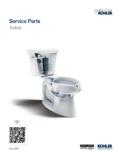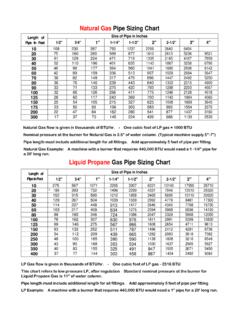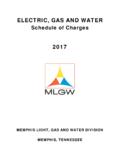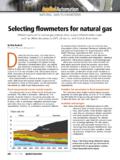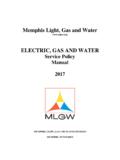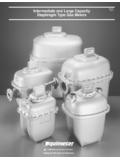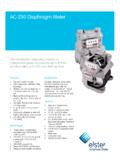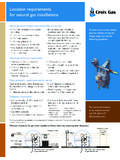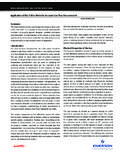Transcription of Gas Piping FactsTANKLESS WATER HEATING
1 Gas Piping FactsTANKLESS WATER HE ATINGI nformation for properly sizing gas lines for use with tankless waterheaters and other gas appliances Rheem WATER HEATING 101 Bell Road Montgomery, AL 36117 any gas appliance, it is essential that the gas supply system be properly sized to support the BTU load of the system. Tankless WATER heaters can be a great solution to provide hot WATER ; however, most tankless WATER heaters have a BTU capacity ranging from 140,000 to 200,000 or more, which makes a tankless WATER heater one of the largest single appliances on a typical gas system. It is necessary to ensure that the system can handle the capacity of the tankless WATER heater along with all other gas appliances on the system.
2 This guide will address the fundamentals and facts of gas pipe sizing for low-pressure (under 2 psi) natural gas systems using rigid iron pipe. For other gas systems, including Propane, Hybrid Pressure, Copper Pipe, and CSST, please consult your local code or the National Fuel Gas Code, NFPA54, ANSI - 2012 Edition. 1 Will a tankless WATER heater work on a -inch gas line? Yes and No. A typical residential gas system is a low-pressure system, meaning that the home is supplied with a gas pressure around 7 in. (inches of WATER column). The Piping must be sized sufficiently enough so that the pressure drop is a half an inch of WATER column or less, when all the gas appliances are on.
3 This can be the limiting factor when trying to use the existing Piping and upgrading from a typical tank-type WATER heater to a tankless WATER heater. Typically, the gas Piping has to be upgraded to support the tankless WATER heater due to the volume of fuel that is required. Tables 2 and 3 provide the capacity by pipe size and length based on the maximum allowable pressure drops. In all cases, a near 200,000 BTU gas appliance will require a minimum of a -inch gas supply line. In specific conditions a -inch gas line may be used. In the 2012 National Fuel Gas Code (NFPA54. ANSI ), a in. pressure drop chart was added for certain conditions. This chart allows a 200,000 BTU gas appliance to be installed on a -inch gas line up to 40 ft.
4 In length. However, the following conditions must be met: The minimum static gas pressure must be 8 in. or greater; The calculated dropped pressure (the static pressure minus the in. pressure drop), must be greater than the highest minimum gas pressure required by any of the gas appliances on the system. See Table 4 for pipes sizes and capacities with a 3 in. pressure drop. To select the correct diameter pipe, first determine the natural gas supply pressure for the system. The characteristics of the installation will specify the correct tables to use in ANSI an existing regulator and meter support a tankless WATER heater? Newer construction gas systems are typically a hybrid pressure system, where the incoming pressure is around 2 psi and each appliance or group of appliances are served by a single regulator.
5 In many older areas and buildings, the system is supplied with a single, low-pressure gas system (around 7 in. ) from the provider. In either case, the capacity of the regulator(s) and meter would need to be checked to ensure that the system can supply enough gas to support the addition of a tankless WATER heater to the system. On low-pressure systems, the pressure must be greater than the highest minimum requirement of the gas appliances plus the associated pressure size gas line will I need for my tankless WATER heater? The gas line size will depend on BTU rating of the WATER heater, the other gas appliances, and where they are installed on each branch from the meter and regulator.
6 There are two methods for determining the required pipe size: the longest length method or the branch length method. See Gas Pipe System Sizing for more do I tell what size regulator or meter I have? Each meter has a capacity in Cubic Feet per Hour (CFH). Locate that number regulator and multiply it by 1,024 (BTUH/CFH) to give you an approximate BTUH capacity for natural gas. The capacity of the meter and regulator must be greater than the total sum of the maximum BTU rating of all the appliances in the home. If the capacity of the system is too small, the gas appliances will not receive the volume of gas required for proper do all these different gas pressures mean?
7 Gas pressure can be measured in two ways: pounds per square inch (psi) or Inches of WATER Column (in. ). The high-pressure side of hybrid pressure gas systems commonly measured in pounds per square inch. This pressure is around 2 psi. Inches of WATER Column is typically used to measure low-pressure gas systems, which is what feeds most appliances. For example, there are in. in 1 psi. What is Inches of WATER Column? Inches of WATER column is a measurement of how much force it takes to push a column of WATER up by a number of inches. It is typically used to measure low-pressure gas systems. How do you measure the gas pressure? You will need an instrument called a Manometer.
8 This tool allows you to measure the pressure of gas in the system. Manometers are available that measures a specific range of pressure in inches of WATER column or pounds per square inch. A digital Manome-ter can measure a broader range of pressures. See the manufacturer s instructions for using the Manometer do you find the BTU rating on my appliances? Each appliance is required to have a rating plate. This plate will list the BTU ratings of the appliance and required gas pressures for proper operation. See the manufacturer s instructions for information on locating the rating plate on each gas a negative pressure gas valve solve an undersized gas system? While a negative pressure gas valve in an appliance can operate at a very low gas pressure, it can have adverse effects on an undersized gas system.
9 This style of appliance can actually rob the gas from other appliances, such as a furnace and possibly cause nuisance outages. The Piping and system must be sized to pass the volume of gas, not just the pressure. How would an undersized gas system affect the appliances? An undersized gas system can cause poor performance in the appliances. It could cause the burners to soot, pilots lights and burners to go out, or cause condensate to form in the heat exchanger of the furnace or WATER heater. Condensate will cause corrosion and eventual failure in appliances not specifically designed for it. Sooting can clog burners or flues which can cause an appliance to fail or produce harmful exhaust gases such as Pipe System FactsRheem WATER HEATING 101 Bell Road Montgomery, AL 36117 Pipe System SizingDetermining the Required Meter and Regulator size.
10 Find the BTU requirement of each appliance in the home. In our example above, we have the following: 199,900 BTU Tankless, a 75,000 BTU Furnace, a 55,000 BTU Range, a 25,000 BTU Dryer, and a 40,000 BTU Gas Log Fireplace. The sum of these appliances is 394,900 BTU. Since most gas regulators and meters are rated in Cubic Feet per Hour, we need to convert the BTU calculation to ensure they are sized correctly. Divide total BTU by 1,024 to get the estimated Cubic Feet per Hour (CFH) requirement for the meter and regulator; 386 CFH in our example. If the WATER heater was a typical tank type at 40,000 BTU, then the overall system requirement would have been just 235,000 BTU with a meter and regulator rated at 235 Cubic Feet per Hour.

